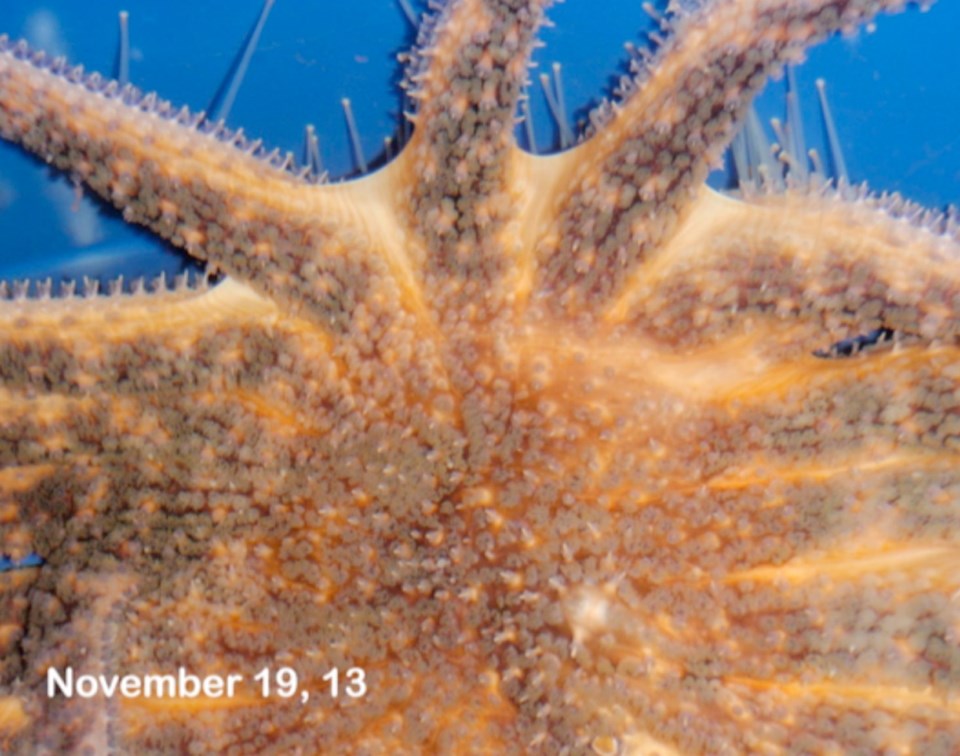Our coastline is losing sea stars by the millions due to what is suspected to be a deadly virus.
The mysterious illness has the potential to wipe out all the sea stars along the west coast of North America, said Paula Romagosa, a marine biologist and curator at the Shaw Ocean Discovery Centre in Sidney.
“Events like this have happened before but on a much smaller scale. We’ve never seen one of this magnitude.”
The die-off of sea stars was first detected in August in small pockets in Howe Sound, off West Vancouver and in Indian Arm.
Since then, the extensive die-off has been reported along the shoreline from Alaska to California.
Laurie Corbeil of Nanaimo noticed something was happening in the ocean close to her home near the Nanaimo Yacht Club.
“I’ve been watching the starfish and a large sea star for a week or two,” she said in an email. “I notice that these are losing their limbs and turning to white goo.”
She went down to the beach at low tide and couldn’t find any sea stars — “only white blotches where they used to be.”
Different species are being hit in different areas. From here to Alaska, it’s the sun star that is dying off. They are reddish on top, covered with brushlike spines and have eight to 14 arms.
From Victoria south to California, the five-armed, purple starfish is mostly affected.
The loss of the species is troubling because sea stars are omnivores and will eat anything, including smaller sea stars.
“Everything in the food chain below them is going to be affected — all the bivalves,” Romagosa said.
“There could potentially be an overpopulation of those species, and overpopulation usually leads to mass mortality from bacterial infections.
“Nature has control,” Romagosa said.
The virus has not yet been identified, but it’s under study at Vancouver Aquarium and some California universities.
“We’re diving as much as possible, trying to document it,” Romagosa said.
Adults are affected more than juveniles, “but in general, it’s affecting everyone,” she said.
Some populations are completely wiped out, including one near the Seattle Aquarium.
“You can see where the sea stars have died and there’s nothing left,” Romagosa said.
It could take decades for the species to recover, Romagosa said.
“It all depends if it continues on, if the populations are completely wiped out, or if the juveniles manage to get past it,” she said.
The virus affects the animals in different ways. A sea star at the Shaw Ocean Discovery Centre showed it was unwell by developing a bald spot.
“It just remained a bald spot for a few weeks,” she said. “There were no changes to behaviour, no change in eating habits. Then, all of a sudden, it turned into several bald spots.”
The sea star was removed from ocean water and placed in quarantine.
“Within five days or so, the sea star got really, really skinny. You could see the webbing between the legs. Then it couldn’t hold onto the walls anymore.”
Others look completely healthy except for their guts coming out in strings.
There is speculation that the die-off could be due to water-borne radiation originating from the Fukushima nuclear plant.
Romagosa said that doesn’t sound likely because the first place it was seen was in a remote area of Indian Arm and not the west coast.
“It could be chemicals that are released into the water from pulp mills or factories. The most possible option is a viral infection.”
There’s little marine biologists can do than let the die-off run its course, she said. “There’s no way of stopping it that we’ve found so far.”


